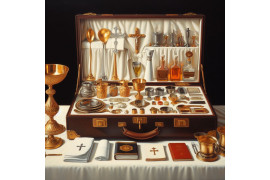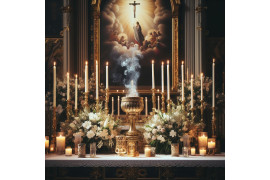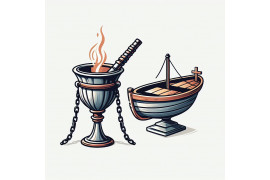Imagine attending a Catholic service and witnessing the priest holding up a small container, carefully cradling it in his hands. You might wonder, what is the difference between this tiny vessel and the ornate chalice used during Mass? Well, I'm here to shed some light on that question.
The answer lies in the distinction between a pyx and a ciborium. A pyx is a small container specifically designed to hold the Eucharist, or consecrated host, during Catholic worship. Its purpose is to safely transport the sacred bread for communion on-the-go. Made from precious metals like gold or silver, pyxes reflect their sacred purpose through their exquisite craftsmanship.
On the other hand, a ciborium serves as a larger vessel used to hold multiple consecrated hosts during Mass. It's typically more elaborate in design compared to a pyx and can be made of similar precious materials.
Now that we've clarified these differences, let's delve deeper into each of these containers and explore their significance within Catholic rituals.
Definition of Ciborium and its Significance in Catholic Worship
A ciborium is a larger vessel used to hold multiple hosts for Mass in Catholic worship. It plays a crucial role in the celebration of the Eucharist, as it serves as the container for the consecrated hosts that will be distributed during communion.
The significance of a ciborium lies in its purpose of safeguarding and reverently storing the consecrated hosts, which are believed to become the body of Christ. This sacred vessel ensures that these consecrated hosts are treated with the utmost respect and reverence throughout the Mass.
Ciboria are often ornately decorated, reflecting their importance in the celebration of the Eucharist. These vessels may feature intricate engravings, precious metals like gold or silver, and sometimes even gemstones. The elaborate designs serve as a visual representation of the significance placed on the presence of Christ during communion.
Importance of Safeguarding Consecrated Hosts
The use of a ciborium allows for efficient distribution of communion to large congregations while ensuring that each host remains intact and protected. This vessel provides a practical solution for preserving and transporting multiple hosts during Mass.
By using a dedicated vessel like a ciborium, there is an added layer of care and reverence given to the consecrated hosts. It emphasizes their sacred nature and signifies their separation from ordinary bread. This distinction helps foster a deeper sense of devotion among believers.
Symbolism in Ornate Designs
The ornate decorations found on many ciboria hold symbolic meaning within Catholic worship. The intricate engravings often depict religious imagery such as crosses, chalices, wheat, grapes, or other symbols associated with the Eucharist.
These embellishments enhance the aesthetic appeal and serve as reminders of Christ's sacrifice and presence during communion. They contribute to creating an atmosphere conducive to prayerful reflection and spiritual connection.
Historical Significance
The use of ciboria dates back centuries, with historical records indicating their presence in Christian worship as early as the 4th century. Over time, their design and usage have evolved, but the fundamental purpose remains unchanged – to hold and protect the consecrated hosts.
The historical significance of ciboria highlights their enduring role in Catholic worship. They serve as a link connecting present-day believers to the rich traditions and practices of their faith throughout history.
Purpose of a Pyx: Holding the Eucharist for Communion on-the-go
The primary purpose of a pyx is to securely hold the consecrated host so that it can be taken outside the church for communion with those unable to attend Mass. Pyxes are specifically designed with tight-fitting lids to ensure that the Eucharist remains intact during transportation.
Pyxes play a vital role in Catholic worship, allowing priests or extraordinary ministers to bring communion to hospitals, homes, or other locations where individuals cannot participate in regular Mass. This enables those who are sick, elderly, or home bound to receive Holy Communion and stay connected to their faith community.
Pyxes offer several advantages:
Convenience and Accessibility
Pyxes provide a convenient way for priests and extraordinary ministers to bring Holy Communion directly to individuals who are unable to attend Mass due to various reasons. Whether it's someone in a hospital bed or an elderly person confined at home, pyxes allow them easy access to the sacrament without having to leave their current location.
Maintaining Sacredness
By using pyxes, the sacredness of the Eucharist is preserved throughout its journey from the church altar to its final destination. The tight-fitting lid ensures that no particles of the consecrated host are lost or damaged during transportation. This attention to detail reflects the reverence and respect given to this central sacrament in Catholic worship.
Symbolic Significance
Beyond practicality, pyxes hold symbolic significance within Catholic tradition. They represent the Church's commitment to inclusivity and ensuring that all members have access to receive Holy Communion. By extending this sacrament beyond the walls of the church building, pyxes embody a sense of unity and compassion within the faith community.
Some pyxes may also contain holy water compartments as part of their design. This allows priests or extraordinary ministers to bring both Holy Communion and holy water for the purpose of blessing individuals or objects during their visits.
Purpose of a Ciborium: Containing the Hosts for Mass
A ciborium serves a crucial role during Mass, specifically in holding multiple hosts that will be used throughout the liturgy. This sacred vessel acts as both a storage and presentation container for the consecrated breads, also known as the blessed sacrament.
By utilizing a ciborium, priests can conveniently access and distribute hosts during various parts of the Mass. It ensures that an ample supply of consecrated bread is readily available to serve all those participating in the Eucharist. The ciborium allows for easy transportation and accessibility, making it an essential tool for priests conducting mass on-the-go or in different locations.
The primary function of a ciborium is to hold and safeguard the hosts until they are distributed to the faithful. This receptacle ensures that these sacred elements remain protected and uncontaminated throughout the duration of the liturgy. It provides a dignified vessel to present the blessed sacrament to worshipers during Communion.
Containers for Consecrated Bread
Ciboria come in various designs and materials, ranging from simple metal containers to ornate chalices adorned with precious metals and gemstones. These vessels often feature lids or covers that help preserve the sanctity of the consecrated bread.
Some ciboria are designed with handles or knobs on top, allowing priests or altar servers to carry them easily during processions or when distributing Communion to those unable to attend Mass physically. The presence of handles facilitates safe handling while ensuring that hosts are not accidentally dropped or mishandled.
Presentation During Liturgical Celebrations
During certain liturgical celebrations, such as Eucharistic processions or Adoration of the Blessed Sacrament, hosts may be presented using other sacred vessels like monstrances instead of ciboria. Monstrances are specifically crafted receptacles designed for displaying consecrated hosts, allowing worshipers to adore the Eucharist.
While ciboria primarily serve as containers for the distribution of hosts during Mass, monstrances emphasize the visual aspect of reverence and adoration. These intricate vessels often feature a transparent glass or crystal center, enabling the faithful to visually connect with the consecrated bread contained within.
Key Differences: Size, Shape, and Design
There are several key differences in terms of size, shape, and design that set them apart.
Size: Small Round vs. Larger Bowl-like
One notable difference between pyxes and ciboria is their size. Pyxes are typically smaller in comparison to ciboria due to their intended purposes. A pyx is a small round container used for holding the consecrated Hosts during Mass. It is designed to be portable and easily carried by priests or Eucharistic ministers. On the other hand, a ciborium is larger and often has a more bowl-like shape with a lid. Ciboria are used to hold a greater quantity of consecrated Hosts for distribution during communion.
Shape: Cylindrical or Rectangular vs. Bowl-like
Another distinguishing factor between pyxes and ciboria lies in their shapes. Pyxes are commonly cylindrical or rectangular, resembling small boxes or cases. This compact form allows for easy storage and transportation of the consecrated Hosts while maintaining their sanctity. In contrast, ciboria have a more pronounced bowl-like shape that accommodates a larger number of Hosts for distribution during Mass.
Design: Simple vs. Elaborate Decoration
The design aesthetic also sets pyxes apart from ciboria. Pyxes tend to have simpler designs with minimal ornamentation. They may feature subtle engravings or religious symbols on the exterior, but generally prioritize functionality over elaborate decoration. Ciboria, however, often exhibit intricate patterns and ornate religious symbols on both the exterior and interior surfaces. These decorative elements add reverence to the vessel itself as it holds the sacred Body of Christ.
In addition to these key differences in size, shape, and design between pyxes and ciboria, it's worth noting that both have their unique significance and purpose within the context of the Catholic Church. Pyxes are primarily used for carrying the consecrated Hosts to those who are unable to attend Mass, such as the sick or home bound. Ciboria, on the other hand, are utilized during Mass to hold a larger quantity of Hosts for distribution to the congregation.
Understanding these distinctions is essential for appreciating the role each vessel plays in the celebration of the Eucharist. While pyxes and ciboria may differ in size, shape, and design, they both serve a sacred purpose by safeguarding and facilitating the distribution of the Body of Christ.
Distinctions in Usage: Pyx for Viaticum, Ciborium for Altar Distribution
In addition to the variations in size, shape, and design discussed earlier, there are also distinct differences in how pyxes and ciboria are used within the context of Catholic liturgical practices.
Pyxes for Viaticum
Pyxes primarily serve a specific purpose known as viaticum. This term refers to the Eucharist that is given to those who are sick or dying as they journey towards eternal life. When someone is unable to attend Mass due to illness or impending death, a priest or extraordinary minister of Holy Communion may bring them the Eucharist using a pyx.
The pyx acts as a sacred vessel that holds the consecrated host during transportation. It ensures that the Eucharist remains protected and reverently carried to those who cannot physically be present at Mass. The use of a pyx allows individuals to receive spiritual nourishment and participate in the sacrament even when they are unable to attend church.
Ciboria for Altar Distribution
On the other hand, ciboria has a different purpose within the Catholic liturgy. They are primarily utilized during Mass for the distribution of communion to the congregation. Unlike pyxes, which are portable vessels meant for individual recipients, ciboria remain on the altar throughout the liturgical celebration.
Ciboria typically have a larger capacity compared to pyxes, since they need to hold enough hosts for multiple communicants. They often feature an ornate design and may be covered with a veil or placed on top of a corporal—a white linen cloth used during Mass—to maintain reverence and cleanliness.
During Mass, after consecrating multiple hosts into the body of Christ, priests distribute communion by placing hosts into ciboria. These ciboria are then brought forth from the altar by priests or extraordinary ministers of Holy Communion, who distribute the Eucharist to the faithful. The use of ciboria allows for a more efficient and organized distribution of communion during Mass.
Appreciating the Unique Roles of a Pyx and a Ciborium
In conclusion, understanding the difference between a pyx and a ciborium is essential in appreciating their unique roles in Catholic worship. While both serve important purposes in the Eucharistic celebration, they have distinct characteristics and uses. A pyx is designed to hold the Eucharist for communion on-the-go, making it convenient for priests to bring the Holy Communion to those unable to attend Mass. On the other hand, a ciborium is used to contain the hosts for Mass, ensuring an ample supply of consecrated bread for distribution during the liturgy.
Now that you know more about these sacred vessels, consider how their significance adds depth and meaning to your faith journey. As you participate in Mass or receive Communion, reflect on the symbolism behind each vessel and appreciate their role in connecting you with Christ's sacrifice. Whether it's witnessing the portability of a pyx or witnessing the abundance within a ciborium, let these vessels remind you of your spiritual nourishment and strengthen your devotion.
FAQs
What materials are pyxes and ciboria made from?
Pyxes and ciboria can be crafted from various materials, such as precious metals like gold or silver, as well as brass or even wood. The choice of material often depends on personal preference, liturgical traditions, and budget considerations.
Can anyone carry a pyx?
While anyone may physically carry a pyx, its use is typically reserved for ordained ministers such as priests or deacons who are entrusted with bringing Holy Communion to those unable to attend Mass due to illness or other circumstances.
How many hosts can a typical ciborium hold?
The capacity of a ciborium can vary depending on its size and design. However, most standard-sized ciboria can hold several hundred consecrated hosts at once, ensuring an adequate supply for the congregation during Mass.
Can a pyx be used instead of a ciborium during Mass?
Although a pyx and a ciborium serve different purposes, in exceptional circumstances where there may be a shortage of ciboria, a pyx can be used as a temporary vessel to hold additional consecrated hosts. However, this practice is uncommon and typically reserved for extraordinary situations.
How should one care for and clean these vessels?
Given their sacred nature, it's important to handle pyxes and ciboria with reverence and care. They should be cleaned regularly using appropriate methods recommended by the manufacturer or the church's guidelines to ensure proper hygiene and preservation of their sanctity.



